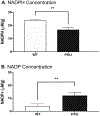Comparative metabolomics in the Pahenu2 classical PKU mouse identifies cerebral energy pathway disruption and oxidative stress
- PMID: 35367142
- PMCID: PMC9759961
- DOI: 10.1016/j.ymgme.2022.03.004
Comparative metabolomics in the Pahenu2 classical PKU mouse identifies cerebral energy pathway disruption and oxidative stress
Abstract
Classical phenylketonuria (PKU, OMIM 261600) owes to hepatic deficiency of phenylalanine hydroxylase (PAH) that enzymatically converts phenylalanine (Phe) to tyrosine (Tyr). PKU neurologic phenotypes include impaired brain development, decreased myelination, early onset mental retardation, seizures, and late-onset features (neuropsychiatric, Parkinsonism). Phe over-representation is systemic; however, tissue response to hyperphenylalaninemia is not consistent. To characterize hyperphenylalaninemia tissue response, metabolomics was applied to Pahenu2 classical PKU mouse blood, liver, and brain. In blood and liver over-represented analytes were principally Phe, Phe catabolites, and Phe-related analytes (Phe-conjugates, Phe-containing dipeptides). In addition to Phe and Phe-related analytes, the metabolomic profile of Pahenu2 brain tissue evidenced oxidative stress responses and energy dysregulation. Glutathione and homocarnosine anti-oxidative responses are apparent Pahenu2 brain. Oxidative stress in Pahenu2 brain was further evidenced by increased reactive oxygen species. Pahenu2 brain presents an increased NADH/NAD ratio suggesting respiratory chain complex 1 dysfunction. Respirometry in Pahenu2 brain mitochondria functionally confirmed reduced respiratory chain activity with an attenuated response to pyruvate substrate. Glycolysis pathway analytes are over-represented in Pahenu2 brain tissue. PKU pathologies owe to liver metabolic deficiency; yet, Pahenu2 liver tissue shows neither energy disruption nor anti-oxidative response. Unique aspects of metabolomic homeostasis in PKU brain tissue along with increased reactive oxygen species and respiratory chain deficit provide insight to neurologic disease mechanisms. While some elements of assumed, long standing PKU neuropathology are enforced by metabolomic data (e.g. reduced tryptophan and serotonin representation), energy dysregulation and tissue oxidative stress expand mechanisms underlying neuropathology.
Copyright © 2022 Elsevier Inc. All rights reserved.
Figures





Similar articles
-
Phenylalanine hydroxylase deficient phenylketonuria comparative metabolomics identifies energy pathway disruption and oxidative stress.Mol Genet Metab. 2021 Apr 7:S1096-7192(21)00686-7. doi: 10.1016/j.ymgme.2021.04.002. Online ahead of print. Mol Genet Metab. 2021. PMID: 33846068
-
Phenylketonuria oxidative stress and energy dysregulation: Emerging pathophysiological elements provide interventional opportunity.Mol Genet Metab. 2022 Jun;136(2):111-117. doi: 10.1016/j.ymgme.2022.03.012. Epub 2022 Mar 29. Mol Genet Metab. 2022. PMID: 35379539 Free PMC article. Review.
-
Mesenchymal stem cell energy deficit and oxidative stress contribute to osteopenia in the Pahenu2 classical PKU mouse.Mol Genet Metab. 2021 Mar;132(3):173-179. doi: 10.1016/j.ymgme.2021.01.014. Epub 2021 Feb 11. Mol Genet Metab. 2021. PMID: 33602601 Free PMC article.
-
DNA methylation in the pathophysiology of hyperphenylalaninemia in the PAH(enu2) mouse model of phenylketonuria.Mol Genet Metab. 2016 Sep;119(1-2):1-7. doi: 10.1016/j.ymgme.2016.01.001. Epub 2016 Jan 14. Mol Genet Metab. 2016. PMID: 26822703 Free PMC article.
-
Are Carriers Unaffected? A Literature Review of Metabolic and Health Outcomes among Genetic Carriers of Phenylketonuria.Lifestyle Genom. 2024;17(1):102-112. doi: 10.1159/000540549. Epub 2024 Jul 30. Lifestyle Genom. 2024. PMID: 39079504 Review.
Cited by
-
Multimodal Metabolomic Analysis Reveals Novel Metabolic Disturbances in Adults With Early Treated Phenylketonuria.JIMD Rep. 2025 Mar 24;66(2):e70010. doi: 10.1002/jmd2.70010. eCollection 2025 Mar. JIMD Rep. 2025. PMID: 40135139 Free PMC article.
-
Current state of the treatment landscape of phenylketonuria.Orphanet J Rare Dis. 2025 Jun 5;20(1):281. doi: 10.1186/s13023-025-03840-y. Orphanet J Rare Dis. 2025. PMID: 40474275 Free PMC article. Review.
-
Creatine energy substrate increases bone density in the Pahenu2 classical PKU mouse in the context of phenylalanine restriction.Mol Genet Metab Rep. 2023 Aug 6;36:100996. doi: 10.1016/j.ymgmr.2023.100996. eCollection 2023 Sep. Mol Genet Metab Rep. 2023. PMID: 37588420 Free PMC article.
-
Pharmacodynamic Mechanisms of Cicadae Periostracum in Parkinson's Disease: A Metabolomics-Based Study.Int J Mol Sci. 2025 Jan 10;26(2):544. doi: 10.3390/ijms26020544. Int J Mol Sci. 2025. PMID: 39859260 Free PMC article.
-
Phenylketonuria (PKU) Urinary Metabolomic Phenotype Is Defined by Genotype and Metabolite Imbalance: Results in 51 Early Treated Patients Using Ex Vivo 1H-NMR Analysis.Molecules. 2023 Jun 22;28(13):4916. doi: 10.3390/molecules28134916. Molecules. 2023. PMID: 37446577 Free PMC article.
References
-
- Guthrie R, Sussi A, A simple phenylalanine method for detecting phenylketonuria in large populations of newborn infants, Pediatrics. 32 (1963) 318–322. - PubMed
-
- Bickel H, Gerrard J, Hickmans EM, Influence of phenylalanine intake on phenylketonuria, Lancet. 265 (1953) 812. - PubMed
-
- MacCready RA, Admissions of phenylketonuric patients to residential institutions before and after screening programs of the newborn infant, J. Pediatr 85 (1974) 383. - PubMed
MeSH terms
Substances
Grants and funding
LinkOut - more resources
Full Text Sources
Medical

